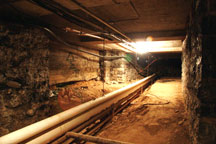
The best-known of the James Madison University myths deals with the mysterious tunnels beneath the Quadrangle and this is one story that does at least have some basis in fact.
There indeed are tunnels under the Quad and some of them are large enough to handle pedestrian traffic of students – as was the case in the institution's earlier years.
The many stories of mystery and mayhem about the tunnels, however, are pure urban legend. You can pick your own myth about the tunnels: violent murder, suicide by hanging, abandoned newborns, strange noises, footsteps or assorted other things that go bump in the night.
Many of the campus tunnels only have crawl space. All the tunnels are now restricted to access only by JMU service technicians.
For about 50 years, however, one of the tunnels was widely used by students and faculty to get from building to building.

In the early years of the Normal School, the heating plant was located next to what is now Harrison Hall. Steam from the plant was distributed through a large tunnel to the campus buildings as their heating source.
The tunnel, about 20 feet wide with 15-foot ceilings, originally connected the campus' first two buildings – then known as Dormitory No. 1 and Science Hall, today known as Jackson Hall and Maury Hall.
The size of the tunnel made it feasible for students and faculty to use it during times of inclement weather to get from one building to the other.
The tunnel was later extended to reach Ashby Hall (originally Dormitory No. 2) and Harrison Hall (originally the Students' Building).
The Students' Building was the do-everything building for the institution's early history. The dining room and post office were located there and it was the center for all student activities. The tunnel made for a quick and dry way to check your mail or have dinner.
Although the lighting was dim in the tunnel – only a bare light bulb every few feet – students from the days of the Normal School, State Teachers College and Madison College all gladly took advantage of getting out of the rain, snow or slush for a shortcut from building to building.
As more buildings were constructed on campus and student support services were spread to other buildings, it became less important for students to have easy access to Harrison Hall.
Sometime around 1960, the use of the tunnel under the Quad was prohibited to students.
And that's when the rumors began to fly.

The most detailed legend about the tunnel deals with a student in the 1920s who is supposed to have received a note to meet her boyfriend in the tunnel.
Her friends warned her about the rendezvous because the girl had been receiving little notes and gifts from an unknown “admirer.” In addition, the campus was on edge because of reports of a Peeping Tom.
She ignored her friends, gussied up and put on her best perfume.
When she arrived in the tunnel, she discovered that her “boyfriend” was actually a crazed stalker. He attacked her, ravaged her and eventually killed her.
Her body was left in the tunnel. It was found the next day by her roommates.
The legend about the murder in the tunnel contains the post script that, even today, you can occasionally catch a whiff of the victim's perfume and hear her footsteps.
There are plenty of other myths but none so elaborate. Among the others:
- A student hanged herself in the tunnel.
- A student had a baby in the tunnel and left it abandoned there.
- The usual collection of strange and unexplained noises.
They are all wonderful stories and fun to tell. They are all, however, pure fiction.
Although the tunnel has long been closed to all but service personnel, curious students will occasionally figure out how to access the old pedestrian tunnel and many leave personalized graffiti on the walls.
The graffiti does not report how many smelled perfume.
-- Fred Hilton
